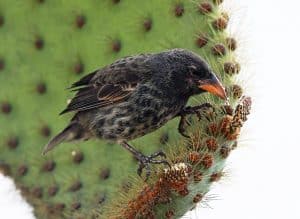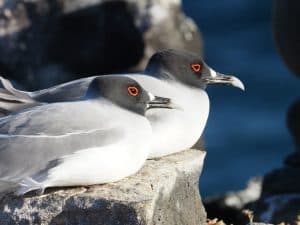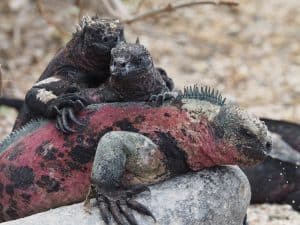From finches to cacti, the fingerprints of evolution are everywhere in the Galapagos
Over the year leading up to my Galapagos trip, I read just about every available book on the islands. My favourite by far was “The Beak of the Finch”, by Jonathan Weiner. Now a nature classic, the book describes how two scientists, Peter and Rosemary Grant, spent more than 20 years on a small Galapagos island proving that Darwin didn’t know the strength of his own theory. They were the first scientists to see evolution by natural selection happening before their very eyes, in real time, and in the wild. They saw that species are not immutable but always in flux. Natural selection is neither rare nor slow, and it is going on everywhere, even in our own backyards.
As the book’s title implies, it is the finches’ beaks that tell the evolutionary story. Adaptive changes in the size and shape of the beak has allowed each of the 17 species to fit into its own ecological niche, be it as small, medium or large seed eaters, nectar eaters, or fruit and insect eaters. DNA testing has confirmed that these birds are all close cousins, having evolved from an original pair of tanager-like birds that arrived on the Galapagos in the distant past from South America. They are also the most famous example of “adaptive radiation”, the process by which organisms diversify from an ancestral species into a variety of new forms.
Thanks to our highly skilled guides, Juan Tapia and Josh Vandermeulen, we saw 12 of the 17 finch species. We stood only metres away as Gray Warbler-finches poured out their warbler-like song from Miconia shrubs; pollen-covered Cactus finches drank nectar from Opuntia flowers; and Medium Ground Finches gleaned seeds from sprawling matplants. Watching them, I tried to remind myself that no other birds have had such a profound impact on human understanding of our own deep history.

Cactus Finch feeding in an Opuntia cactus. Both species tell an amazing story of evolution. (Josh Vandermeulen)
As I think back on these wonderful seven days, a flood of other bird memories come to mind, too. First among these were the Waved Albatross we saw at a nesting colony on Espanola Island. With a wingspan of over seven feet, they are the islands’ largest breeding bird. We were lucky to be there in courtship season and to see the elaborate ritual between male and female. This included bill circling, bill clacking, and a formalised dance with the bill raised vertically. The colony is located beside a low cliff where a strong updraft allows the birds to take off with relative ease. It was mesmerizing to watch not only albatross but a host of other seabirds as they soared along the cliff.
There were many other special moments, too: a male Nazca Booby courting a female by dutifully gifting her with pebbles; flocks of Red-billed Tropicbirds streaming overhead; tiny Red-necked Phalaropes riding the giant sea waves; Espanola Mockingbirds licking condensation off our water bottles; Short-eared Owls camouflaged among the rocks and waiting to pounce on storm-petrels; Lava Herons and Lava Gulls blending in perfectly against their namesake; and Swallow-tailed Gulls flashing their spectacular wing pattern. I was able to photograph a pair of these gulls sitting side by side in the late afternoon sun. With its heart-shaped, scarlet eye ring, one of the birds seems to be saying, “I love you!”

A pair of Swallow-tailed Gulls-the worlds only nocturnal gull. Note the heart-shaped eye-ring on the upper bird. (Drew Monkman)
Giant tortoises
“Galápagos” is an old Spanish word for giant tortoise. When Darwin visited the islands in 1835, the Vice Governor told him that he could tell which island a given tortoise came from by the shape of its shell. Scientists now believe they know why. Those with a saddle-shaped carapace evolved on islands where they had to reach up high to feed on vegetation like cacti, while those with a domed carapace became adapted to feeding at ground level with no reaching up. In the highlands of Santa Cruz Island, thousands of Galapagos Giant Tortoises live in harmony with farmers. We walked among these colossuses – some five feet long, 400 pounds and over 100 years old – close enough to hear them ripping and chewing grass from the pasture. Others were wallowing in the mud of shallow ponds, seemingly oblivious to our presence and to that of the beautiful White-cheeked Pintails that swam among them.
Earlier that same day, we had visited the amazing Charles Darwin Research Station, which is a key player in the conservation of the Galapagos. Three-quarters of the staff at the station are Ecuadorian residents of the islands. This is part of a huge effort to help the islanders themselves engage with protecting the biodiversity and to become not only guides but also future scientists.
The station carries out a very successful tortoise captive breeding program, and we were able to see baby tortoises of several species. Thousands of tortoises have been re-introduced to islands where the original population has been decimated by everything from invasive rats and goats to whalers killing the tortoises for food.
There are also wonderful displays on evolution, such as the story of how Marine Iguanas and three species of land iguanas all evolved from an ancestral pair of South American Green Iguanas. The latter probably arrived millions of years ago on floating vegetation from the mainland. Seeing the black Marine Iguanas with their barnacled foreheads, erect spines, and habit of expelling salt from their nostrils, it’s easy to understand why Darwin famously called them “imps of darkness.”
Amazing plants
The story of evolution is also written in the plants of the Galapagos. It is especially evident in the 15 species of Scalesia, the Darwin’s finches of the plant world. A member of the daisy family, Scalesia have adapted to different vegetation zones and evolved into trees and shrubs. In the highlands of Santa Cruz, we saw 15 metre Tree Scalesia, which are akin to giant sunflower trees with their ultra-fast growth, ray flowers, and soft pithy wood. On other islands, we saw shrub-like Radiate-headed Scalesia, which is a pioneer on barren lava.
The six species of Opuntia cacti are yet another example of the power of evolution. The tallest is the Giant Prickly Pear, which grows to 12 metres tall and develops beautiful, rich brown bark. I was particularly fascinated, however, by the Opuntia species we found on Genovesa. Because there are no cacti-eating herbivores on this island, this Opuntia has soft spines. Why? Because there was never any adaptive pressure to put resources into making the spines hard and piercing. Amazing.
Climate Change
As isolated as the Galapagos are, they are not immune to the effects of climate change. Most of the iconic species stand to suffer as do the coral reefs. Warming seas, which are made worse by El Nino events, may already explain why sardines have become rare, and why sardine-eating Blue-footed Boobies no longer nest there. The climate crisis is also predicted to increase the rate and intensity of El Nino events, which are devasting for marine life as the seas warm. The effect ripples through the entire ecosystem and has a negative impact on everything from Galapagos Sea Lions to Marine Iguanas. Unfortunately, increased rainfall will be a boon to many invasive species.
As someone who writes constantly about climate change, there is maybe an element of hypocrisy in my even making this trip. We all know that flying has a huge carbon footprint. But how many of us are going to give up air travel or completely reinvent the way we live as individuals? A winter get-away, for example, is a part of so many people’s lives, as are retirement travel and visiting far-flung family members. That is why addressing climate change lies not so much in personal action (although there is much we can do personally) but rather in transitioning our entire economy away from fossil fuels to renewable, carbon-free energy. This may also lead to new technologies for less carbon-intensive air travel. Both a price on carbon and strict new emission regulations are essential to achieving this transition.
In the meantime, one thing we can also do is purchase carbon offsets whenever we fly. This is a system by which you compensate for your share of a flight’s carbon footprint by donating to offset carbon emissions elsewhere. Carbonfootprint.com allows you to easily calculate your personal footprint for a given flight. By clicking the “Offset Now” button, you can then choose a project to help fund. Our Galapagos trip footprint was 1.68 metric tons of carbon. We chose “Reforestation in Kenya” and paid $25 as an offset. Carbon offsets typically cost 5% or less of the ticket price. They are a great tool for all of us who are fortunate enough to fly regularly.
I came home from the Galapagos feeling incredibly privileged to have been able to visit the very cradle of evolutionary theory and observe first-hand the iconic species that taught the world about natural selection. Seeing so much wildlife with no fear of humans – the mother sea lions with their wide-eyed pups, for example – also made me think about how tragic it is that we humans – the very creatures of which they are so trusting – are responsible for a climate crisis that is likely to wreak havoc on their fragile lives.
Local Climate Change News
Well-known Canadian author and journalist, Gwynne Dyer, will present “The Climate Horizon: A Lecture” on Feb. 11 at 7:30 pm at Gzowski College, Trent University. “Climate change will have exponential influences on our military, politics, environment, social systems and economy, but with an unprecedented level of global co-operation, there might be a way through it,” according to Dyer. Please register at Eventbrite.ca for this free event.
